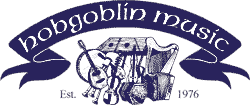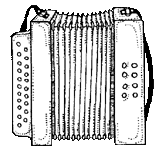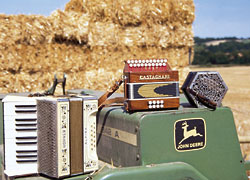
| THE HOBGOBLIN INFO SOURCE | |||
| HOBGOBLIN INDEX PAGE | HOBGOBLIN INFO INDEX | CATALOGUE CONTENTS | MELODEON ONLINE SALES | SECONDHAND PRICES |
| Melodeon FAQ | ||||
 |
ON THIS PAGE: Melodeon History Choosing a Melodeon English Style Cajun & Tex-Mex Irish & Chromatic Style Keyboard Diagrams RELATED PAGES: Melodeon Makers Caring for Your Instrument |
 | ||
|
© Copyright Hobgoblin Music 1983, 2000. This text may be freely distributed in whole or in part so long as the copyright holder is clearly acknowledged. This FAQ is developing from information in the Hobgoblin catalogue, Very much from the English view of the world, as most of Hobgoblin's melodeon customers are English. I plan to develop the page from where it is now, contributions are encouraged, in the form of questions or info. Melodeon HistoryThe Melodeon was developed from the Harmonica and other primitive free reed instruments early in the 19th century, in the border area between Saxony and Bohemia. The Abbe Georg Josef Vogler had a role in introducing the concept of the free reed principle to Europe and by his death in 1814 many prototype instruments were being made with a variety of names and shapes. The earliest instrument is said to be the Aeolidicon made by Eisenach in Hamburg in 1800. The Harmonica itself is said to have been perfected by Buschmann in 1821. The Melodeon fingering system is still basically the same today, very similar to a Harmonica on the right hand, with a different note on the push & pull of the bellows, and bass notes and chords on the left hand. The instrument has a naturally rhythmic sound, and has been absorbed into traditional music worldwide.Choosing your MelodeonWhat tuning should I get?Firstly you need to know what style of music you will mainly want to play, the most popular styles are listed below, and each call for a different tuning. Apart from the style you prefer, you should consider what key your friends use, so you can join in and learn from them, and the pitch of your voice. We would always recommend you to start on a two row, D/G normally, or B/C for Irish music. In France, and most parts of North and South America G/C is preferred, while in Germany C/F is the standard, and the Club Model is a popular variant with two and a half rows. Whatever the key, all 2 row diatonics have the same fingering, and you donít need to re-learn anything to play on a melodeon in a different key. D/G is the highest pitch of the diatonics, followed by C/F, A/D, and G/C, which is lowest. How Many Rows?The basic melodeon has one row of 10 treble keys, and 4 bass keys. This type provides a cheap (but limited) way to begin the melodeon. Some people find a one row in G useful, because it plays an octave below the G row of a D/G. An instrument in D is highest in pitch followed by C, A, and G, which is the lowest. More useful is the two row, which is the most popular and useful option. The outer row is tuned either a 4th (diatonic system) or a semitone (chromatic system) below the inside row. A two row will usually have eight basses. Sometimes an extra half row is added on diatonics to give a wider range of notes. A three row, gives a third available key in diatonics, or alternative fingerings in chromatics, but many players find three rows a bit bulky. What does tremolo mean?On a box which has more than one set of reeds it is possible to tune one reed slightly sharper than the other, so that a beat or tremolo effect occurs, this can give the sound an extra sharpness and clarity, as in the Hohner pokerwork. The Paolo Soprani type instruments usually have the most tremolo, and the Castagnaris have either dry (almost no tremolo), or swing (about half as much tremolo as a Hohner) tunings. Musette tuning is popular in Scotland and France, but is going out of favour in Ireland. This means 3 sets of reeds, one tuned sharp, and one flat, a very wet sound. Price and Quality FactorsThe other important factors to consider are the sound you like, and you will just have to listen to find that out, the speed and accuracy of response (which is generally related to the price), and how comfortable it is to hold. The price you should pay obviously depends on your budget, but we wouldnít recommend a beginner to buy the most expensive model, or an experienced player to choose one which will hold them back. English & other Diatonic Styles
Most English dance bands, and Morris musicians use a 2 row with D/G tuning, which is ideal for those keys and the related minors, but not for any others. A three row A/D/G gives the key of A, together with more flexibility particularly in the bass. Why are there high notes at the bottom of the keyboard?These are diatonic instruments, in that they only play the basic scale without sharps and flats. Quite a few tunes call for extra notes not in the diatonic scale, so some instruments are provided with the most useful accidentals instead of the two lowest notes at the end of each row. Delicias and Hohners are tuned like this, Castagnaris are available with or without accidentals, and Paolo Sopranis come without. Serenellini & Saltarelle models with 23 treble keys have both low notes & accidentals. The loss of the low notes can be a problem, and one solution is to position the accidental notes as an extra half row, as on the Castagnari Dony, and Serenellini Nimbus. Cajun & Tex-MexCajun musicians use an old style 10 key one row, with four sets of reeds, each set can be individually selected by the use of the stops and quite a variety of tone can be produced. The most popular tuning is C, but D is also common. Cajun music is played in a blues style, and transposes the music up one fifth, so to play in G you need a C box, and a D box will give A.The other main use of diatonic tunings is in Tex-Mex, where G/C and G/C/F are preferred. Flaco Jimenez plays a Hohner Corona in G/C/F.Irish & Chromatic Style Irish and Scottish musicians usually prefer the Chromatic system. On these instruments the rows are tuned only a semitone apart, so that all the sharps and flats are available. The treble keyboard can play in any key, but you will be limited by what the bass can provide in the way of chords. 12 bass models give more scope, but many traditional players donít use the basses at all. Models with 23 treble notes give nearly a 3 octave range in this tuning. The most popular tuning is B/C, and it is quite simple to play in D or G on this by playing across the rows. Using the same fingering you can get the keys of E and A out of a C#/D box, or just play it in D. C/C# is becoming less popular. A three row in B/C/C# gives you more options, and more bass notes. John Kirkpatrick uses a three row chromatic, and the B/C is standard in Irish ceilidh bands.Keyboard Diagrams
Back to the Top of the Page |